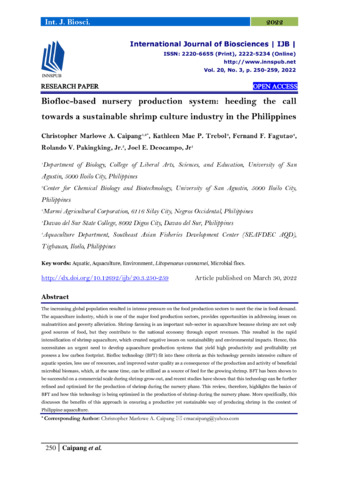Perlihatkan publikasi sederhana
Dietary lipid requirement of whiteleg shrimp Litopenaeus vannamei juveniles cultured in biofloc system
| dc.contributor.author | Hamidoghli, Ali | |
| dc.contributor.author | Won, Seonghun | |
| dc.contributor.author | Aya, Frolan | |
| dc.contributor.author | Yun, Hyeonho | |
| dc.contributor.author | Bae, Jinho | |
| dc.contributor.author | Jang, In-Kwon | |
| dc.contributor.author | Bai, Sungchul C. | |
| dc.date.accessioned | 2019-12-02T00:32:49Z | |
| dc.date.available | 2019-12-02T00:32:49Z | |
| dc.date.issued | 2020-06 | |
| dc.identifier.citation | Hamidoghli, A., Won, S., Aya, F. A., Yun, H., Bae, J., Jang, I., & Bai, S. C. (2020). Dietary lipid requirement of whiteleg shrimp Litopenaeus vannamei juveniles cultured in biofloc system. Aquaculture Nutrition, 26(3), 603–612. | en |
| dc.identifier.issn | 1353-5773 | |
| dc.identifier.uri | http://hdl.handle.net/10862/3559 | |
| dc.description.abstract | An eight-week feeding trial was conducted to evaluate the contribution of biofloc on dietary lipid requirement in whiteleg shrimp Litopenaeus vannamei. Five diets with graded levels of dietary lipid (45, 60, 90, 120 and 150 g/kg) were fed to juvenile shrimp. Final weight, weight gain and specific growth rate of shrimp fed diets with 60, 90 and 120 g/kg lipid levels were significantly higher than those of shrimp fed diets with lipid levels 45 and 150 g/kg (p < .05). Feed efficiency and protein efficiency ratio of shrimp fed 60, 90 and 120 g/kg were higher than those fed 150 g/kg diet. Plasma total cholesterol and triglyceride levels were lower in shrimp fed 45 g/kg compared with those fed the 90 g/kg (p < .05). Also, lysozyme activity for 90 g/kg group was higher than the 15 g/kg group. Hepatopancreas lipase and amylase activities of shrimp fed 90 and 120 g/kg diets were significantly higher than those of shrimp fed 45 and 150 g/kg diets. Broken-line regression analysis for weight gain indicated that the dietary lipid requirement of whiteleg shrimp juveniles reared in a biofloc system was estimated to be higher than 56 g/kg but <60 g/kg. | en |
| dc.publisher | Wiley | en |
| dc.title | Dietary lipid requirement of whiteleg shrimp Litopenaeus vannamei juveniles cultured in biofloc system | en |
| dc.type | Article | en |
| dc.identifier.doi | 10.1111/anu.13021 | |
| dc.citation.volume | 26 | |
| dc.citation.issue | 3 | |
| dc.citation.spage | 603 | |
| dc.citation.epage | 612 | |
| dc.citation.journalTitle | Aquaculture Nutrition | en |
| dc.subject.asfa | shrimp culture | en |
| dc.subject.asfa | diet | en |
| dc.subject.asfa | juveniles | en |
| dc.subject.asfa | feed composition | en |
| dc.subject.asfa | growth | en |
| dc.subject.asfa | fish oils | en |
| dc.subject.asfa | lipids | en |
| dc.subject.asfa | regression analysis | en |
| dc.subject.asfa | hepatopancreas | en |
| dc.subject.asfa | growth rate | en |
| dc.subject.asfa | feeding experiments | en |
| dc.subject.asfa | biofloc technology | en |
| dc.subject.asfa | levels | en |
| dc.subject.asfa | feed conversion efficiency | en |
| dc.subject.asfa | weight gain | en |
| dc.identifier.essn | 1365-2095 | |
| dc.subject.scientificName | Penaeus vannamei | en |
| dc.subject.scientificName | Decapoda | en |
| dc.subject.scientificName | Litopenaeus vannamei | en |
| local.subject | biofloc | en |
| local.subject | dietary lipid | en |
| local.subject | growth performance | en |
| local.subject | haematology | en |
| local.subject | immune response | en |
| local.subject | whiteleg shrimp | en |
Files in this item
| Files | Size | Format | View |
|---|---|---|---|
|
There are no files associated with this item. |
|||
Publikasi ini ada di koleksi berikut
-
Journal Articles [1256]
These papers were contributed by Department staff to various national and international journals.




